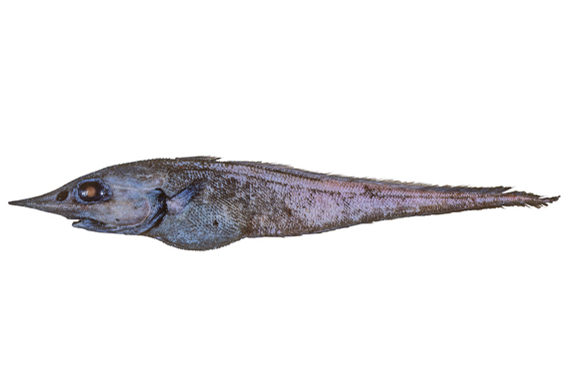- Classification
- ACTINOPTERYGII
- GADIFORMES
- TRACHYRINCIDAE
- Trachyrincus
- longirostris
Unicorn Whiptail, Trachyrincus longirostris (Günther 1878)
Other Names: Slender Unicorn Rattail, Unicorn Rattail, White Whiptail

Unicorn Whiptail, Trachyrincus longirostris. Source: Australian National Fish Collection, CSIRO. License: CC by Attribution-NonCommercial-ShareAlike
Summary:
A pale greyish to brownish whiptail with a dark greyish mouth and gill cavities, and greyish fin. Juveniles are darker overall. The scales are strongly adherent and covered in spinules.
Cite this page as:
Bray, D.J. 2022, Trachyrincus longirostris in Fishes of Australia, accessed 24 Apr 2024, https://fishesofaustralia.net.au/home/species/4360
Unicorn Whiptail, Trachyrincus longirostris (Günther 1878)
More Info
|
Distribution |
East of Newcastle Bight, New South Wales, to southwest of Beachport, South Australia. Elsewhere the species occurs in southern Africa and New Zealand. |
|
Features |
Dorsal fin II, 9–12 + 110+; Pectoral fin 19–24; Pelvic fin 6–7; Gill rakers (inner)13–16; Branchiostegal rays 7; Pyloric caecae 35–62; Scutes - dorsal 21–36, ventral 40–64. Body long, slender, and compressed posteriorly; head broad, snout stoutly supported by bone, depressed, and narrowly triangular in dorsal view, snout length 41–46% HL; ventral length of snout 34–39% HL; jaws extending to below mid-orbit or slightly beyond, upper jaw length 25–28% HL; chin barbel tiny. Orbit diameter 27–31% HL; Interorbital width 20–25% HL. Scales strongly adherent, heavily spinulated; pyloric caeca bifid at tips; skeletal structure rigid and stout. |
|
Etymology |
The specific name longirostris is from the Latin longus (= long) and rostris (= snout), in reference to the snout being “produced into a long flattened process, pointed anteriorly, and not quite twice as long as the large eye”. |
|
Species Citation |
Macrurus longirostris Günther 1878, Annals and Magazine of Natural History 5 2(2, 22, 28): 23. Type locality: off East Cape, North Island, New Zealand, Challenger Station 169, depth 700 fathoms. |
|
Author |
Bray, D.J. 2022 |
|
Resources |
Unicorn Whiptail, Trachyrincus longirostris (Günther 1878)
References
Günther, A. 1878. Preliminary notices of deep-sea fishes collected during the voyage of H.M.S. Challenger. Annals and Magazine of Natural History 5 2(2, 22, 28): 17-28, 179-187, 248-251 See ref at BHL
Günther, A. 1887. Report on the deep-sea fishes collected by H. M. S. Challenger during the years 1873-76. Report on the Scientific Results of the Voyage of H. M. S. Challenger 22(57): i-lxv + 1-268, Pls. 1-66. (as Trachyrhynchus longirostris) See ref at BHL
Iwamoto, T. 1990. Family Macrouridae. pp. 90-318 in Cohen, D.M., Inada, T., Iwamoto, T. & Scialabba, N. FAO Species Catalogue. Gadiform fishes of the world (order Gadiformes). An annotated and illustrated catalogue of cods, hakes, grenadiers and other gadiform fishes known to date. FAO Fisheries Synopsis No. 125. Rome : FAO Vol. 10 442 pp.
Iwamoto, T. & Graham, K.J. 2001. Grenadiers (Families Bathygadidae and Macrouridae, Gadiformes, Pisces) of New South Wales, Australia. Proceedings of the California Academy of Sciences 52(21): 407-509 figs 1-114 See ref at BHL
Iwamoto, T. & McMillan, P.J. 2008. Family Macrouridae. pp. 320-347 in Gomon, M.F., Bray, D.J. & Kuiter, R.H. (eds). Fishes of Australia's Southern Coast. Sydney : Reed New Holland 928 pp.
McMillan, P. 1994. Family Macrouridae. pp. 340-364 figs 304-325 in Gomon, M.F., Glover, C.J.M. & Kuiter, R.H. (eds). The Fishes of Australia's South Coast. Adelaide : State Printer 992 pp. 810 figs.
McMillan, P.J. 1995. Review of trachyrincine grenadier fishes (Pisces: Macrouridae) from New Zealand, with a description of a new species of Trachyrincus. New Zealand Journal of Marine and Freshwater Research 29(1): 83-91 https://doi.org/10.1080/00288330.1995.9516642
McMillan, P.J. & Iwamoto, T. 2015. Families Macrouridae, Bathygadidae, Macrouroididae, Trachyrincidae. pp. 747-838 in Roberts, C.D., Stewart, A.L. & Struthers, C.D. The Fishes of New Zealand. Wellington : Te Papa Press Vol. 3 pp. 577-1152.

